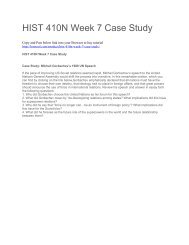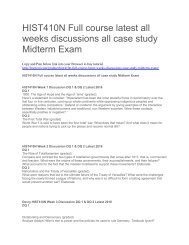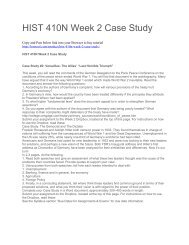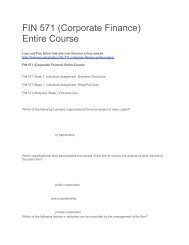GED 210 Unit 2 Examination Answers
Create successful ePaper yourself
Turn your PDF publications into a flip-book with our unique Google optimized e-Paper software.
<strong>GED</strong> <strong>210</strong> <strong>Unit</strong> 2 <strong>Examination</strong><br />
<strong>Answers</strong><br />
Copy and Pate below link into your Browser to buy tutorial<br />
http://hwpool.com/product/ged-<strong>210</strong>-unit-2-examination-answers/<br />
<strong>GED</strong> <strong>210</strong> <strong>Unit</strong> 2 <strong>Examination</strong> <strong>Answers</strong><br />
1. One goal of anthropological linguistics is to determine the number of phonemes<br />
(phoneticstructure) that exist in different languages. This goal is accomplished by employing the use<br />
of:<br />
minimal pairs<br />
phone taps<br />
maximal differences<br />
syntax units<br />
2. The word “lower” contains:<br />
two bound morphemes<br />
two bound phonemes<br />
two free morphemes<br />
one bound morpheme and one free morpheme<br />
3. The words “boy” and “girl” are:<br />
bound phonemes<br />
bound morphemes<br />
free morphemes<br />
bound phones<br />
4. An example of a bound morpheme in English is:<br />
the phrase “boys will be boys”<br />
the word “boys”<br />
the word “boy”<br />
the “s” in the word “boys”<br />
5. How many morphemes are there in the English word “antidisestablishmentarianism”?<br />
1<br />
6<br />
28<br />
0<br />
6. The goal of ethno semantics is to understand:
that reality is inherently unorganized and can be perceived in any way; thus, color<br />
naming, plant classification, and time categories are completely arbitrary<br />
the meanings of words, phrases, and sentences and how members of other societies use<br />
language to organize things, events, and behaviors<br />
that languages and behavior are the same<br />
that classification systems in all societies are random<br />
7. Linguistic anthropologists find that people who are forced to abandon their native language<br />
and culture:<br />
begin to lose their self-esteem<br />
all speak English<br />
are better off socially and economically<br />
easily regain both in 100 years<br />
8. The concept of ____________ maintains that societal change occurs when societies borrow<br />
cultural traits from one another.<br />
functionalism<br />
structuralism<br />
evolutionary dispersal<br />
diffusionism<br />
9. The body of anthropological theory concerned with the spread of technology, religion,<br />
economic systems, art forms, and other expressions of culture is known as:<br />
idealism<br />
particularism<br />
functionalism<br />
diffusionism<br />
10. Grafton Eliot Smith and William Perry, major figures associated with the school of British<br />
diffusionism in the early 20th century, proposed that:<br />
each culture has a key personality type<br />
a culture can only be interpreted in the context of its own historical development<br />
culture’s principal function is establishing institutions to guide behavior<br />
all aspects of civilization are derived from the culture of ancient Egypt<br />
11. In order for diffusionism to work as envisioned by the British and German schools, adherents<br />
had to assume or maintain all of the following ideas except:<br />
some peoples were not sufficiently innovative to develop their own cultural traits<br />
inherent inferiority of different non-western peoples was assumed<br />
cultural traits that were diffused were part of the technological dimension of the society<br />
cultural traits in the same geographical region would inevitably spread from one society to<br />
another
12. One of boas’ principal criticisms of nineteenth century anthropologists was that:<br />
they failed to make use of archaeological evidence for pre-literate societies<br />
their theories were based on “armchair anthropology” and not their own fieldwork<br />
there was too much cultural relativism in their interpretations<br />
they failed to assign adequate importance to biological effects on culture<br />
13. According to Franz Boas, in order to conduct a historical particularist study of a society, one<br />
must adopt the notion of ___________, or the belief that each society should be understood in terms<br />
of its own cultural practices and values.<br />
particular evolution<br />
cultural relativism<br />
lagged diffusionism<br />
functionalism<br />
14. During your lifetime you will probably be a member of two families, the family of orientation<br />
(the family into which you were born and enculturated) and the family of __________ (the family in<br />
which you will have or adopt children).<br />
acculturation<br />
deculturation<br />
procreation<br />
life<br />
15. Which of the following is not a function of the family?<br />
nurture and enculturation of children<br />
regulation of sexual activity<br />
protection and support for members<br />
regulation of statuses, roles, and gender<br />
16. A typical ____________ family consists of two parents and their immediate biological offspring<br />
or adopted children.<br />
basic<br />
atomic<br />
extended<br />
nuclear<br />
17. Marriage within the same social group or category is __________, while __________ is<br />
marriage between people from different social categories or groups.<br />
incest; outcest<br />
endogamy; exogamy<br />
in-marriage; out-marriage<br />
monogamy; polygamy
18. From a female perspective, you will be a daughter and possibly a mother and wife. As such,<br />
you assume what are called __________ roles that correspond to these different status positions.<br />
family<br />
social<br />
gender<br />
temporary<br />
19. The relationship between age and status is an anthropologically interesting subject. Which of<br />
the following statements concerning age and status is correct?<br />
Since age is biologically determined, the statuses attached to each age category are the same<br />
in every culture around the world.<br />
The elderly occupy a high level of status in all societies.<br />
Anthropologists doing cross-cultural research have found that age does not influence status;<br />
statuses are either ascribed at birth or earned during one’s lifetime, and they donot change even if one<br />
ages.<br />
Anthropologists have found that age stratification varies in accordance with the level of<br />
technological development; the elderly have relatively high status in many preindustrial societies, but<br />
experience a loss of status in most industrial societies.<br />
20. “Fission” and “fusion” in hunting and gathering societies refer to:<br />
hazards of contacts with the industrialized world<br />
cyclical change in population density relative to resources<br />
decision-making processes used by tribal leaders<br />
the dynamics of wild plant resources<br />
21. Hunting and gathering societies will sometimes resort to infanticide in order to:<br />
engage in more frequent intercourse<br />
supplement scarce hunting resources<br />
reduce the effects of anticipated food shortages<br />
make sacrifices to tribal gods<br />
22. Which of the following would not have the effect of lowering fertility?<br />
marriage at an older age<br />
weaning babies at an older age<br />
practicing infanticide<br />
an earlier onset of menarche<br />
23. The most likely reason why hunter-gatherer technology is limited to simple tools made of<br />
stone, wood, and bone is because foraging peoples:<br />
lack the basic intelligence necessary to make anything more complex<br />
are too busy looking for food to spend time on more advanced tools<br />
have not acquired knowledge of more sophisticated technologies<br />
substitute profound knowledge of their environment for complex tools<br />
24. The principal technology used for obtaining plant foods by tropical foragers is the:<br />
boomerang<br />
blowgun and darts
polished stone axe<br />
digging stick<br />
25. The _________ produced the most extensive material culture found among hunting and<br />
gathering societies.<br />
Kung San<br />
Eskimo<br />
Shoshone<br />
Mbuti
















